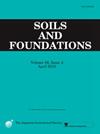基于人工大样本和深度学习的粗粒土分级识别
IF 3.3
2区 工程技术
Q2 ENGINEERING, GEOLOGICAL
引用次数: 0
摘要
在土石坝、路基、机场和其他堤坝工程中,级配信息是评估填料质量和适用性的基础。针对现有基于图像的轮廓识别方法和机器学习方法在识别小粒径范围方面的局限性,本研究建立了首个公开可用的粗粒土数据库,包括黄河淤泥和石英砂数据集,粒径范围从 0.075 毫米到 20 毫米,共包含 22,380 幅图像。随后,在深度残差网络(ResNet)的基础上,提出了一种新颖的卷积神经网络(CNN)架构--搜索分析网络(SaNet),通过将单个等级下的多幅图像作为输入来提高等级识别的准确性。最后,通过特征图可视化讨论了模型的可解释性。结果表明,SaNet 对黄河淤泥的 MAE¯ 为 1.63 × 10-2,R2¯ 为 0.995;对石英砂的 MAE¯ 为 1.21 × 10-2,R2¯ 为 0.992。同时,所需的额外计算时间和存储空间仅比 ResNet 多 3.5 % 和 0.3 %,可在 10 ms 内完成单幅图像的识别。本研究的结果表明,所提出的 SaNet 模型可以立即实现高精度的色阶识别,从而满足相关任务中对实时、无损色阶检测的需求。本文章由计算机程序翻译,如有差异,请以英文原文为准。
Recognizing gradations of coarse soils based on big artificial samples and deep learning
In earth-rockfill dams, roadbeds, airports, and other embankment projects, gradation information serves as the basis for evaluating the quality and suitability of fill materials. Addressing the limitations of existing image-based contour recognition methods and machine learning approaches in recognizing small particle size ranges, this study establishes the first publicly available coarse-grained soil database including Yellow River Silt and Quartz Sand datasets, with particle sizes ranging from 0.075 to 20 mm, comprising a total of 22,380 images. Subsequently, a novel Convolutional Neural Network (CNN) architecture, the Searcher-Analyzer Network (SaNet), based on the Deep Residual Network (ResNet), was proposed to enhance the accuracy of gradation recognition by taking multiple images under a single gradation as input. Finally, the interpretability of the model was discussed through feature map visualization. The results demonstrate that SaNet achieves of 1.63 × 10−2 and of 0.995 for Yellow River Silt, and of 1.21 × 10−2 and of 0.992 for Quartz Sand. Concurrently, the additional computational time and storage requirements are only 3.5 % and 0.3 % more than those of ResNet, allowing the recognition of a single image to be completed within 10 ms. The findings of this study indicate that the proposed SaNet model can instantly achieve high accuracy in gradation recognition, meeting the demands for real-time, non-destructive gradation testing in related tasks.
求助全文
通过发布文献求助,成功后即可免费获取论文全文。
去求助
来源期刊

Soils and Foundations
工程技术-地球科学综合
CiteScore
6.40
自引率
8.10%
发文量
99
审稿时长
5 months
期刊介绍:
Soils and Foundations is one of the leading journals in the field of soil mechanics and geotechnical engineering. It is the official journal of the Japanese Geotechnical Society (JGS)., The journal publishes a variety of original research paper, technical reports, technical notes, as well as the state-of-the-art reports upon invitation by the Editor, in the fields of soil and rock mechanics, geotechnical engineering, and environmental geotechnics. Since the publication of Volume 1, No.1 issue in June 1960, Soils and Foundations will celebrate the 60th anniversary in the year of 2020.
Soils and Foundations welcomes theoretical as well as practical work associated with the aforementioned field(s). Case studies that describe the original and interdisciplinary work applicable to geotechnical engineering are particularly encouraged. Discussions to each of the published articles are also welcomed in order to provide an avenue in which opinions of peers may be fed back or exchanged. In providing latest expertise on a specific topic, one issue out of six per year on average was allocated to include selected papers from the International Symposia which were held in Japan as well as overseas.
 求助内容:
求助内容: 应助结果提醒方式:
应助结果提醒方式:


